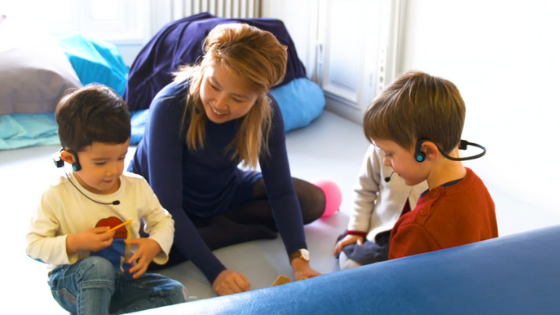Autism Awareness - Using Forbrain with individuals on the spectrum!
Can you believe that it’s April already?! Despite all the craziness that 2020 is throwing at us, time keeps on ticking on, and April means that it’s Autism Awareness Month! As a Speech & Language Therapist, I’ve been working with children with Autistic Spectrum Disorder (ASD) for almost a decade now, so for part of Autism Awareness month I wanted to share with you some of my best therapy tips for working with children with ASD.

Warm-Up With Movement
Most children with ASD that I work with have a multidisciplinary team of therapists and carers working together, and I have been lucky enough to work alongside some really excellent Occupational Therapists over the past few years. What I have learnt from them is that sensory activities and movement are absolutely key for helping children with ASD regulate themselves so that they can be ready to participate in therapy! By including these types of activities I have seen children with ASD become more alert and present, which makes for much more successful therapy sessions. They’re also fun activities, so kids are always happy to participate!
Some of my go-to sensory/motor activities are:
- Sitting on yoga balls facing each other, bouncing together
- Placing the child’s belly on the yoga ball and letting them roll forwards (so that their head goes down, their weight might go onto their hands depending on how long their arms are) and back again
- Slowly swinging in a swing
- Bouncing in a lycra hammock
- Crawling through tunnels or over cushions
If you don’t have any of these items available, you can still include sensory/motor activities!
- Animal walks (Giraffe: stretch up tall and walk on tip-toes; Bear: walk on all fours with your bottom in the air; Elephant: stomp and swing your arms like a trunk)
- Slowly applying deep pressure (squeezes) to different parts of their body using your hands
- Spinning them in your arms and crashing onto a couch
- Even something as simple as stretching up high then reaching down to touch the ground, or jumping together!
The key to these activities is to keep the child regulated, so we want things that are fairly calm and rhythmic rather than total chaos. Some strategies I use to make sure that the activities stay rhythmic and calm include counting out loud to 10 or 20, or singing a song while we move.
Include Songs!
A lot of the children with ASD that I have worked with really love music, so songs are another great thing to include in sessions. For children who are non-verbal or minimally verbal, songs can be a great stepping stone to communication.
When including songs, I keep it fairly simple and stick to the classics: Wheels on the Bus, If You’re Happy, Heads Shoulders Knees and Toes etc. I especially love songs that have actions! I also love to have the child wear Forbrain while we sing songs (see below for more info).

Once you have included songs for a while and you know that the child is familiar with the songs and enjoys them, you can try singing part of the song (Ex. “The wheels on the bus go….”) and then pausing to see if the child will do something to indicate that they want the song to continue. When you pause make sure to do “expectant waiting”; looking at the child with an excited expectant face and leaning slightly towards the child so that they know something is required. Some of the things to look for include:
- Making eye contact
- Making a vocalisation
- Filling in an action
- Singing the next word or line of the song
For children who are just learning to communicate, even something as simple as moving their body excitedly lets us know that they’re anticipating what’s coming next.
Wait for 5-10 seconds, and if the child doesn’t do any of these things, continue anyway or prompt them by helping them do the action using their hands.
Assistive Technologies
Assistive Technologies are widely used when working with children with ASD. The most commonly used assistive technologies include Augmentative Alternative Communication (AAC) devices to help children learn to communicate, but there are other types of technologies that we can also use with children with ASD. For the past two years I have been using a device called Forbrain, which is basically a small microphone that is attached to a head-set that uses bone conduction to give you real-time, slightly amplified input of your own speech or vocalisations. I have found that it has multiple uses when working with children with ASD:
- For children who are non-verbal it can help them become aware of their own voice and increase their vocalisations.
- For children who are verbal it can motivate them to talk more, and the slightly louder input can also help reinforce new language targets.
- For children who have trouble staying present, it can help them stay grounded and focussed as it gives them slightly louder feedback compared to background noises that might otherwise be distracting to them.
- For children working on academic school-work the louder input can help them retain new information while simultaneously helping them to stay on task.

When introducing this with children with ASD, I recommend modelling how it is used first: I will put the Forbrain on myself during an activity, then after a while I say “your turn!” and place it on the child. For children who are defensive about things around their ears, you might need to start off more gently, and have their “turn” just be having the Forbrain sitting next to them, then sitting on their legs, then in their hands, touching their bellies, touching their shoulders, and eventually working up to their ears (this may happen in one session, or it may happen across multiple sessions). In an ideal world we could even have two Forbrain headphones, one for myself and one for the child so that we can wear them together.
There are no magical activities or special exercises to do with the Forbrain; the best way to use it is to simply place it on the child during your normal session activities (particularly those involving vocalisations/speech/language). I aim to use it for 10 - 30 minutes per session.
Be a Friend First
This last one is a no-brainer, but still needs to be said! Given that children with ASD have difficulty with social interactions, it is crucial that we make ourselves a fun person that they are motivated to interact with and target social skills activities for autism. How we do this may look different with each child, but it basically boils down to one simple thing: whatever the child is interested in, find a way to incorporate it into your sessions. This goes for children of all ages and abilities! For a child that loves spinning, we can use our expectant wait and practice “ready, set…... go!” before spinning them; for a child that loves trains we might do a lot of vocal play using our Forbrain saying “CHOO CHOO!” while we play with trains; for a child that loves food maybe we can have picnics or tea parties and teach first words/signs like “more” and “eat” and “all done”; for a child that loves Paw Patrol maybe we can teach verbs using Paw Patrol characters “Rubble is eating!” “Chase is running!”. The opportunities are endless, we just have to get creative!
Thank you for celebrating Autism Awareness Month with me! I hope you found something interesting to take away from this post, and I look forward to learning more alongside all of the professionals making a difference to children with ASD this month.

Grace is a Speech and Language Pathologist and is based in Paris, France

.png?width=1900&name=blog_banner%20(1).png)

